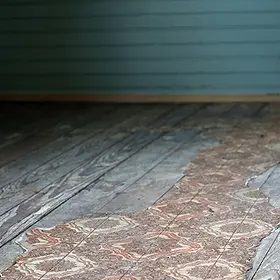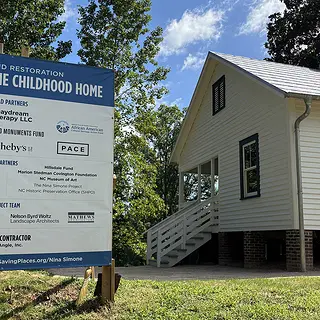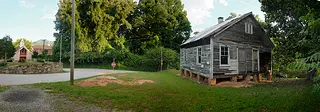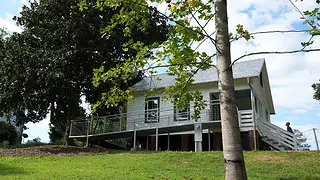Nina Simone Childhood Home Restoration Project

Learn more about the preservation process and step inside Nina Simone’s childhood home.

African American Cultural Heritage Action Fund
Nina Simone’s distinctive voice, powerful blend of classical, blues, and gospel music, and passionate civil rights activism ensured that her decades-long legacy endures.
Despite her fame, until a few years ago little was known about Simone’s childhood home in Tryon, North Carolina. In 2016, the humble, three-room clapboard house where she spent her childhood and began learning to play the piano was in severe disrepair and put up for sale.
With the threat of its impending demolition, four African American artists sprang into action. Painter Adam Pendleton, sculptor and painter Rashid Johnson, collagist and filmmaker Ellen Gallagher, and abstract artist Julie Mehretu founded Daydream Therapy, LLC and collectively bought the home for $95,000.
With leadership and guidance from the four artists, the National Trust for Historic Preservation's African American Cultural Heritage Action Fund served as lead partner with Tryon’s East Side neighborhood residents; award-winning composer Dr. Samuel Waymon, Nina Simone's brother; St. Luke CME Church, where Simone’s mother was a minister; and a team of construction, architectural, and philanthropic partners to begin saving the home for future generations.
Through the dedicated advocacy, fundraising, and preservation expertise of this network of supporters, the home’s rehabilitation was completed in Fall 2025. Stay up to date on the next phase of this project by subscribing to the Nina Simone Childhood Home email list.

Learn more about the preservation process and step inside Nina Simone’s childhood home.

photo by: Nancy Pierce
Before it was saved by Daydream Therapy LLC, Nina Simone’s Childhood Home was in severe disrepair.
Nina Simone was born Eunice Waymon in Tryon, North Carolina in 1933. As a young girl, she attended her mother’s sermons at St. Luke CME church and began playing the piano during services. After hearing Simone accompany the community choir at the Tryon Theater at the age of six, Mrs. Muriel Mazzanovich, a local piano teacher, convinced her mother that given her extraordinary talent she should pursue lessons. Mazzanovich began teaching Simone at her house in Tryon and organized the Eunice Waymon Fund to raise money for her to continue her education through high school.
To thank those who supported the fund, Simone performed her debut recital at the Tryon Library in 1943 at age 11. However, living in a Jim Crow-segregated South, Simone’s parents were forced to give up their seats for white audience members when they arrived. Simone refused to play until her parents were returned to their rightful place in the front row.
Following her high school graduation, Simone moved to New York City in 1950 to attend a summer program at Juilliard and apply for a scholarship at the Curtis Institute of Music in Philadelphia. However, Curtis rejected her application—allegedly due to her race.

photo by: StroudProductions
1969 publicity photo of Nina Simone.
Instead, she worked odd jobs before she began playing piano and singing at a bar in Atlantic City. It was there that she changed her name to Nina Simone and her career as the High Priestess of Soul was born.
Through the 1960s, Simone built a reputation as an artist and civil rights activist. She maintained personal friendships with Dr. Martin Luther King Jr. and Malcolm X, and the violence of the Civil Rights Movement and tragic events such as the 16th Street Baptist Church bombing, motivated Simone to express her ideas and emotions through explosive original songs such as “Mississippi Goddam” and “Four Women,” and acclaimed covers including “I Wish I Knew How it Would Feel to be Free.”
Following her passing in 2003, broader recognition of Simone’s historic significance has resulted in the Oscar-nominated feature film What Happened, Miss Simone? released in 2015; NPR’s inclusion of her 1965 song “I Put a Spell on You” as the number three album on their 150 Greatest Albums Made by Women list; and her 2018 induction into the Rock & Roll Hall of Fame.

photo by: Morgan Forde
A preservation-compliant ADA accessibility ramp enables front and rear access to the home.

photo by: Nancy Pierce
Nina Simone Childhood Home, shown pre-rehabilitation, where the Waymon family lived in 1933.

photo by: Morgan Forde
St. Luke CME Church, where Nina Simone’s mother was a minister, is located across the street from the home.

photo by: Nancy Pierce
Downtown Tryon Historic District, listed on National Register of Historic Places in 2015.
Opportunity
Develop a rehabilitation plan and create additional protections for Simone’s home.
Related Stories
Explore More Places
Join us in protecting and restoring places where significant African American history happened.
Learn More